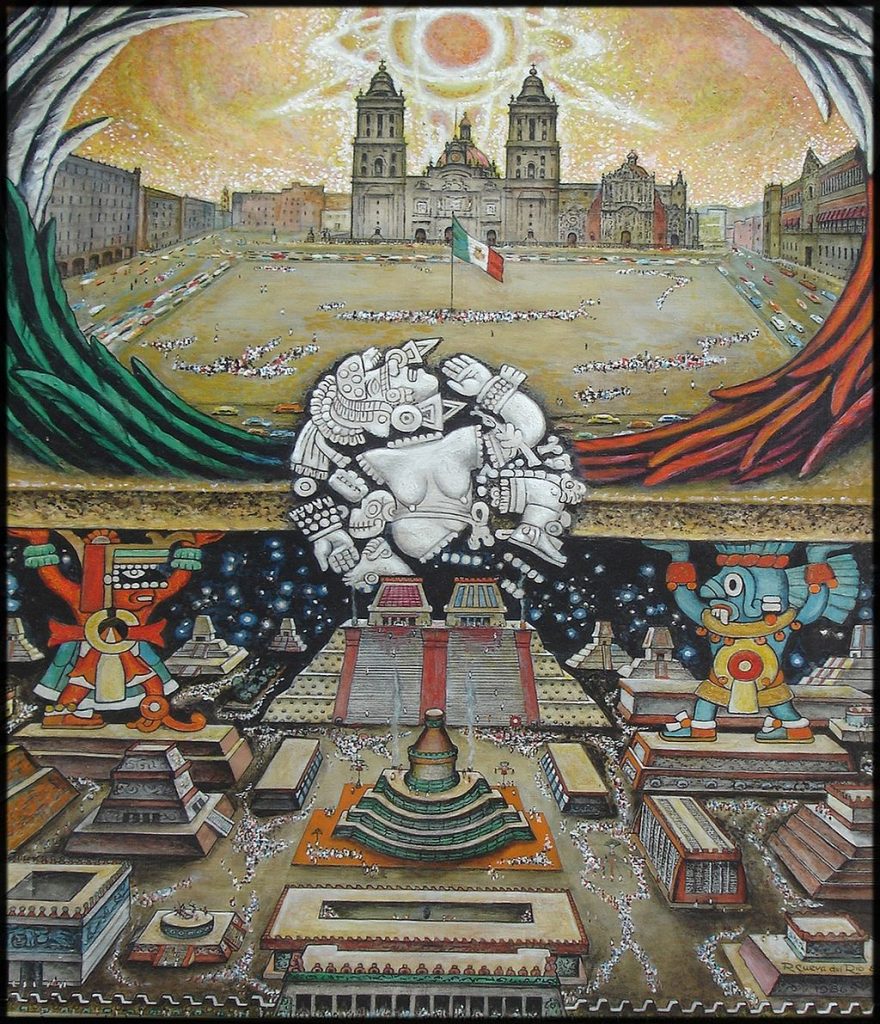When the Spanish conquistadors arrived in the valley of Mexico, they discovered something mystical. They viewed this place as the Venice of the New World. There were glamorous pyramids, exceptionally clean streets, grand aqueducts, lavish ball courts… all floating on a lake. This magical city, known as Tenochtitlan, was built by the Aztecs, the same group of people many look down upon because of their brutality, ferocity, and their practice of human sacrifice. Though many view the Aztecs as cold-hearted murderers, this is not the full story. Yes, they did practice human sacrifice, but much like other civilizations, they also had art, building projects, literature, religion, and a rich culture. But how is it that these people became a superpower of the Americas?
According to legend, the Aztecs, also known as the Mexica, hailed from a beautiful place known as Aztlan, which means “Land of the cranes.” Much like the mythical Greek city Atlantis, no one really knows where Aztlan is or even if it existed. In fact, the Aztec story about Aztlan is only one of several origin stories they tell. One legend has it, however, that one day their god, Huitzilopochtli, told the Mexica people to leave their land and find a new home, and they did. After more than two centuries of migrating, the Mexica grew more and more desperate to find that new home. Then they discovered the valley of Mexico. But they weren’t the only ones to settle there. Tribes such as the Azcapotzalco, the Culhuacán, and the peoples of Texcoco had gotten there long before they had. The only land that was still available to the Mexica was the nasty marshlands around Lake Texcoco, which the others had not wanted. And yet it was here that the Mexica had a vision. It was here that their sun god Huitzilopochtli gave them a sign: an eagle perched on a cactus eating a snake. That is why Mexico’s flag today has an eagle eating a snake. It meant that the Mexica (the Aztecs) had finally found their new home.1
Settling down in the Valley of Mexico was anything but easy. For one thing, objects would sink easily in the poor marshy grounds, which were in the middle of Lake Texcoco; yet this is where the Aztec’s creative engineering would come into play. Under their leader Tenoch, from which the name Tenochtitlan comes, the Aztecs began building their new home, by trading waterfowl and fish for wood and stone from the other tribes.2 With the wood, they made stakes, which were driven into the marshy ground. They then filled the gaps in between the stakes with mud and stones, which would become a foundation for their city. In order to connect the island city to the mainland regions, they also made gigantic causeways, using the same principles for making their foundation and were several miles long. Another problem was the water in Lake Texcoco, which was salty. The Aztecs had to build an aqueduct that would transport fresh water from the distant Chapultepec hills to the city itself. This aqueduct used a pair of stone pipelines that used gravity to transport the water to the city, and parts of it still stand to this day.3 Though they fixed their foundation and their water problems, there was still one problem that the Aztecs had to face before they could become the dominant force of Mesoamerica.
As their population kept growing, the demand for food kept rising at an alarming rate, and this is where the Aztecs are distinct from other civilizations. First, they dug canals into the island’s marshes and chopped down the plants that were growing there. They then piled reeds on top of each other to make rafts and covered them with mud. Finally, they planted willows underneath the rafts to anchor them. And voilà, the Aztecs had their very own artificial floating gardens, known as chinampas. With water always available, these chinampas could produce crops year round, thus the Aztecs had an abundance of beans, corn, tomatoes, squash, and flowers.4

After several generations, Tenochtitlan became a city of wonder and reached a population of around 200,000 inhabitants, making it one of the largest cities in the world.5 The city was decorated with structures, such as the serpent wall that enclosed the sacred quarters of the city and contained the carvings of snakes. It also contained lavish temples, such as the temple of Xipe Totec and the temple of Quetzalcoatl, the god of the sky and wind. But at the heart of Tenochtitlan was an impressive sight to see. This magnificent edifice, known as the Templo Mayor, was a temple like no other. This 150 feet pyramid had a twin staircase that led up to the glamorous temples of Tlaloc, the rain god, and Huitzilopochtli, the same god who provided the Aztecs with the vision of their new home.6

In the Aztec tongue, Nahuatl, their word for city is actually two words in English: water mountain (atl tepetl).7 In many ways, Tenochtitlan was a mighty mountain that watched over the valley of Mexico with its striking glare. Long before Mexico City became a glimpse in the eyes of history and replaced this magnificent place, Tenochtitlan was a flourishing capital that was not necessarily built by a brutal and violent race. But rather by a people who didn’t let the impossible stop them from making their home a legendary reality.
- Jennifer Stock, “Tenochtitlán Is Founded,” Global Events: Milestone Events Throughout History, (Farmington Hills, MI: Gale, 2014), 23-24. ↵
- Jennifer Stock, “Tenochtitlán Is Founded,” Global Events: Milestone Events Throughout History, (Farmington Hills, MI: Gale, 2014), 23-24. ↵
- Sonia Benson, “The Rise of the Aztecs,” Early Civilizations in the Americas, Vol. 2 (Detroit: UXL, 2005), 465. ↵
- Sonia Benson, “The Rise of the Aztecs,” Early Civilizations in the Americas, Vol. 2 (Detroit: UXL, 2005), 461-462. ↵
- Sonia Benson, “The Rise of the Aztecs,” Early Civilizations in the Americas, Vol. 2 (Detroit: UXL, 2005), 461. ↵
- Charles Phillips, Aztec and Maya: The Complete Illustrated History: The Greatest Civilizations of Ancient Central America with 1000 Photographs, Paintings and Maps (New York: Metro Books, 2008), 430-431. ↵
- Charles Phillips, Aztec and Maya: The Complete Illustrated History: The Greatest Civilizations of Ancient Central America with 1000 Photographs, Paintings and Maps (New York: Metro Books, 2008), 56-57. ↵




43 comments
Christopher Vasquez
I did not know that the Aztecs were able to solve their population problem by creating make-shift agricultural gardens called chinampas. I also was not sure how Tenochtitlan obtained its name, so I think it’s fascinating knowing that it came from the leader Tecnoch. This great civilization accomplished a civilization unlike any other in the Americas. The Aztec, although they could be brutal, were geniuses (chinampas) and very educated, which can be seen with the structure and organization of their city. This article was great!
Greyson Addicott
The way this article described the Aztec people, one could easily believe that the Aztec actually had it better than their modern Mexican successors. They weren’t run by a “party” (gang) for over 100 straight years, they had a competent, feared military, they were respected by their neighbors, and separate factions didn’t constantly do battle within their nation. The Aztec people were certainly one of the more advanced civilizations of the New World, even though they refused to use the wheel for practical, real-life scenarios. They had a civilization equivalent to that of the early Romans, but they were ultimately unable to advance it fast enough to keep up with the Old world.
Jose Sanchez
This article was very well written. I enjoyed reading on the history of the origins of the Aztecs and their city. It still leaves me in awe that Aztec engineers were able to accomplish these feats that have stood the test of time. We often think of the great civilizations as being the Romans or Greeks, but the Aztecs deserve that recognition as well.
Maisie Favila
I really enjoy reading about the Aztecs and their history, so from the get-go this article was intriguing. The architecture they created along with the art is ridiculously gorgeous and intricate. I am shocked that I had never heard of this city before in any of my history classes. Tenochtitlan is such a beautiful city and I can’t imagine how long it took to come about. I liked this article a lot and I’m glad I learned about this!
Damian Jennings
The city of Tenochtitlan, was compared to the city of Atlantis, it was of similar intent and its creation was astonishing, these people constructed a paradise for themselves. Even though they were limited of materials and knowledge, they managed to build a city that would suite all of their needs; eventually these people had to flee in sight of a new home. This home became the valley of Mexcio.
Nathan Alba
I think people forget how smart Aztecs actually were. Everyone remembers their savagery, but no one remembers everything they did to create one of the largest cities in the world. Sure their religious ideals may have been out there, but this article causes the reader to remember all that the Aztecs contributed to the advancements of society. I mean floating gardens is really some next level stuff.
Ariana Melendez
Prior to this articles, I had heard about the Aztec peoples and their influence on Mexico. However, this article does a good job in informing us about the myths of the Aztecs, as well as proof their existence and dominance in Mexico. I like how this article described the keen qualities of this tribe through their innovations. The prevalence of religion is also seen when the Aztecs followed the sign that their God gave them.
Madeline Torres
I thoroughly enjoyed reading this article. It’s amazing how the Aztecs grew to become a stable civilization under such difficult circumstances. The history of the Aztecs is very interesting to learn about, and I really liked the fact that the author included the meaning behind the snake on the Mexican flag. I had absolutely no idea that the snake meant the homecoming of the Aztecs. I loved the details included in this article, very well written.
Caden Floyd
I couldn’t imagine finally arriving in a new land and discovering the beauty that is Tenochtitlan. When the Mexica people were forced to settle in the valley they were dealt a bad hand, but chose to make the best of it and envisioned the beautiful city they would create. I think it is cool how they built their city and mile long causeways using primitive building methods. This article was fun to read and taught me about something I have never really had prior knowledge of.
Sofia Andrade
I had heard of Tenochtitlan before and about the history behind the eagle on the Mexican flag but did not have insights on the details of this city. Through this article it is clear that the building and maintaining of this city was not easy and it took intriguing work. This magnificent city of Tenochtitlan proved to me that the Aztecs were advanced in their thinking in order to build such a great city.